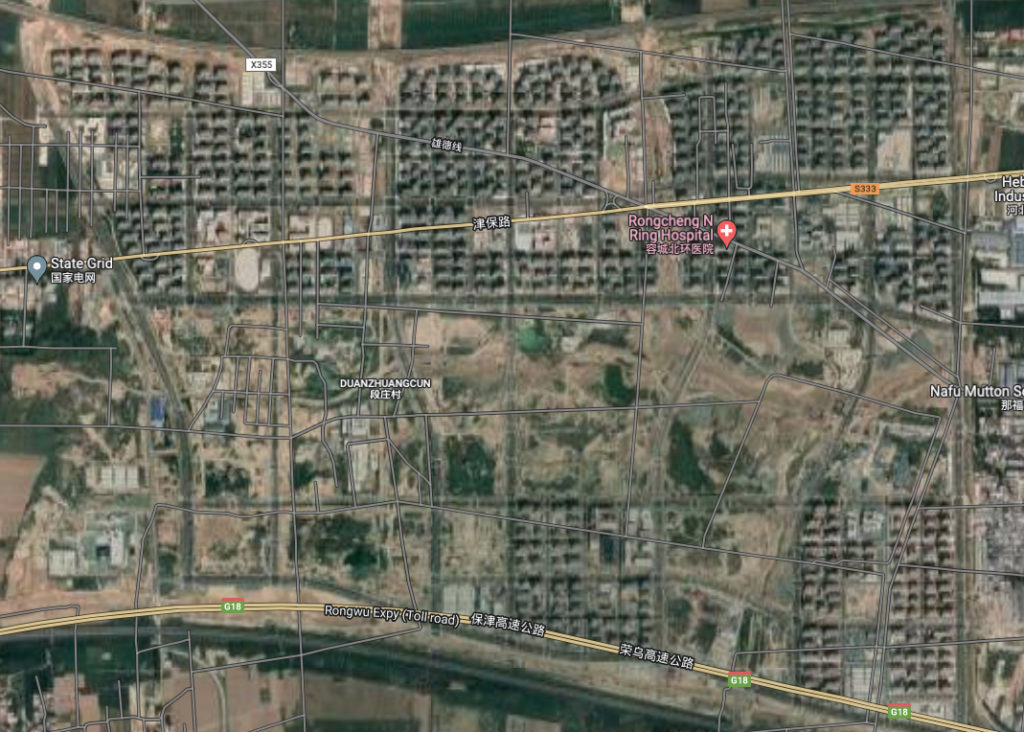Due to issues of politics, congestion, or just plain corruption, nations get the bright idea to build brand new capital cities far away from existing urban areas. Sometimes it works out (as with Washington D.C.), and sometimes it doesn’t. China’s Xi Jinping is trying something different with Xiongan, which is being built not so much a replacement to Beijing but as sort of “mini-me” Beijing to relieve overcrowding by offloading functions to the new built-from-scratch city in Hebei* province.
About 60 miles south of the center of Beijing, a new city is being built as a showcase of high-tech ecologically friendly development. Its massive high-speed rail station and “city brain” data center have been heralded by Chinese state media as evidence of the speed and superiority of China’s growth model—not least because the city is a “signature initiative” of Chinese President Xi Jinping.
Commies (and their American fans) do love their high speed rail projects. Never mind that high speed rail in China has mostly been a trillion dollar, money losing sinkhole.
Xiongan New Area is also a test for whether China can boost domestic innovation and climb into the ranks of advanced nations in the face of slowing economic growth and efforts by the United States and others to restrict its access to advanced technology.
Xiongan offers a window into what Xi’s vision of state-led innovation looks like on the ground. Xi has called the city his “personal initiative” and a qiannian daji, or “thousand-year plan of national significance.”
You know who else had a thousand year plan?

Sorry, I just can’t resist a good Hitler meme when you pitch a slow ball right over the center of the plate…
The plan for Xiongan, which was formally unveiled in 2017 to relieve pressure on Beijing and promote the “coordinated regional development” of the Beijing-Tianjin-Hebei region, has faced financial struggles due to the huge investment costs—even more of a problem given China’s mounting real estate crisis. Overall, the new area encompasses about 650 square miles, with a planned population of around 3 million; currently, the three counties comprising the zone have around 1.4 million long-term residents. As of September 2022, 400 billion yuan (about $57 billion) in completed investment had been reported in the city overall.
While Xi has stacked the new Politburo Standing Committee with officials loyal to him, he has also elevated those with strong science and engineering backgrounds. In his speech at the 20th Party Congress last October, Xi declared that “innovation will remain at the heart of China’s modernization drive” and that China has “worked hard to promote high-quality development and pushed to foster a new pattern of development.” Nevertheless, a confluence of factors including COVID-19 lockdowns and trade tensions is contributing to overall slower growth in China.
In Xi’s vision, however, party control is not a hindrance to innovation. Rather, Xi’s vision of innovation is one in which the state and party play a leading role. Xi has led a crackdown on private technology firms such as Alibaba but has also promoted policies, such as his Made in China 2025, that aim to boost research-and-development spending and subsidies to give Chinese firms competitive advantages in industries including biotechnology, robotics, artificial intelligence, and semiconductors.
We know from experience that this approach almost never works, because the profit motive of capitalism is always a superior discovery mechanism for innovation than top-down bureaucratic mandates. We know that the state-led approach has already been a colossal failure for semiconductors even before the sanctions came down, and it’s a good bet that it’s been just as colossal a failure in all the other areas mentioned.
Xi’s policies favor “hard tech” over software-based platform app companies. The first party secretary of Xiongan was Chen Gang, who oversaw Beijing’s Zhongguancun high-tech park before being transferred to Guizhou, where under Xi ally Chen Miner he helped turn the southwestern province into a center of big data and cloud computing.
The approach to innovation in Xiongan involves embedding technology within the fabric of the city as well as innovation processes within the party-state. Xiongan Group was created as the investment vehicle for the area’s overall development, under the control of Hebei province but backed partially by loans from China Development Bank. The first central state-owned enterprises to begin construction of offices in the new area were China Satellite Communications Co., the energy giant China Huaneng Group, and Sinochem Holdings. Others now include the big three telecoms and China State Grid, as well as China Mineral Resources Group, a conglomerate set up last year to centralize China’s coal mining industry. These state-owned enterprises could use Xiongan as a test bed for new technologies. Research institutes and satellite branches of several Beijing universities are planning to open in the area around 2025. The relocation of these major units and their thousands of employees will determine how quickly Xiongan’s development proceeds.
Even as China’s economy has slowed during COVID-19 lockdowns and the global downturn, construction of the first phase of Xiongan has marched on: A huge high-speed rail station to connect the city with Beijing opened in 2020, followed by residential slabs, massive underground utility corridors, and the city brain data center, which will serve as the nerve center of the city’s digital systems. The first section, Rongdong, has been mostly completed, with housing for 170,000 people. Media reports of new schools opening show the effort to build high-quality public amenities to attract residents to the city: Branches of Beijing institutions such as Shijia Primary School and Tsinghua University High School are among the new educational institutions being built in Xiongan.
The Foreign Policy piece is OK as a sort of sanitized, high level overview, but lacks several key words (“shoddy,” “rotten,” “unsafe,” “tofu dregs,” etc.) that reflect the grittier reality of Xi Jinping’s dream:
Takeaways:
It’s hard to find on Google maps, but I think this spot shows the same cookie cutter buildings seen in the video.

Ghost city, tofu dregs, rotten tail; parts of Xiongan seem to check all three boxes.
*Note: Hebei Province is completely different from Hubei Province further south…